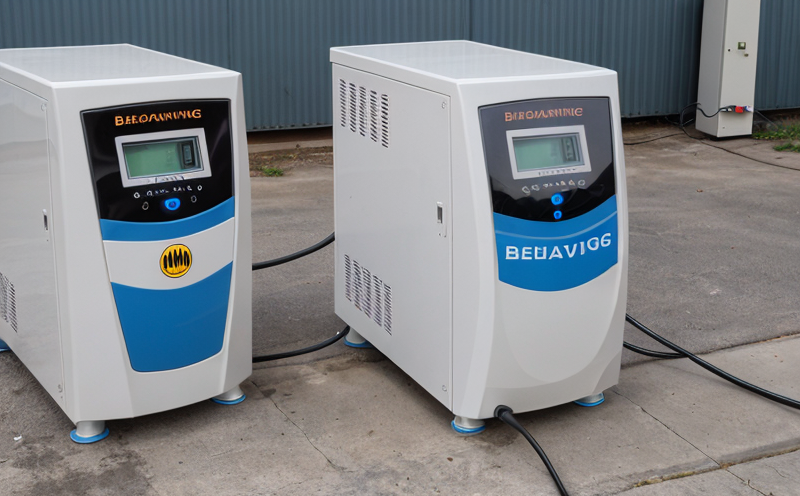SAE J2289 Charging and Discharging Testing of EV Battery Modules
The SAE J2289 standard provides a comprehensive framework for assessing the charging and discharging behavior of electric vehicle (EV) battery modules. This testing is critical for ensuring that batteries meet performance, safety, and durability requirements set forth by regulatory bodies and industry standards.
Charging and discharging tests are essential in evaluating how well an EV's battery can hold a charge under various conditions. These tests simulate real-world scenarios, such as rapid charging during travel or extended periods of low power usage, to ensure the battery’s integrity over its lifecycle. Understanding these behaviors helps manufacturers optimize battery design and performance, while also providing data for consumers regarding expected battery life.
The SAE J2289 protocol specifies a series of tests that simulate different charging rates, depth of discharge (DoD), temperature conditions, and cycle counts. These parameters are crucial in assessing the longevity and efficiency of EV batteries. By adhering to this standard, manufacturers can ensure their products meet stringent requirements for safety, performance, and reliability.
The testing process involves several stages. First, the battery module is subjected to various charging rates, typically ranging from 0.5C up to 10C. This range allows for a broad understanding of how quickly the battery can be charged under different conditions. Following this, discharging tests are conducted at varying depths and temperatures. The depth of discharge refers to the percentage of charge removed from the battery during use; it is crucial in evaluating how much energy the battery can deliver before requiring a recharge.
Temperature control plays a significant role in SAE J2289 testing, as extreme conditions can greatly impact battery performance and lifespan. The tests are conducted at ambient temperatures ranging from -40°C to 65°C, which simulates both cold winter climates and hot summer environments. These temperature variations help researchers understand how well the battery performs under typical usage scenarios.
The number of cycles is another critical factor in SAE J2289 testing. A cycle consists of a full charge and discharge of the battery. The standard specifies that batteries must undergo at least 1,000 cycles to ensure longevity. This extensive cycling helps identify any degradation or failure points within the battery’s structure. By performing these tests, manufacturers can assess not only immediate performance but also long-term reliability.
The results of SAE J2289 testing are used by quality managers and compliance officers to verify that EV batteries meet all necessary standards. R&D engineers rely on this data to refine designs and improve battery technology. Additionally, procurement teams use these test results to select reliable suppliers who can deliver high-quality components.
Understanding the charging and discharging behavior of an EV battery module is vital for both manufacturers and consumers. It ensures that vehicles have a reliable power source capable of withstanding various environmental conditions. This knowledge also contributes significantly to reducing carbon emissions by promoting more efficient and sustainable transportation solutions.
Why It Matters
The SAE J2289 standard is essential for the automotive industry, particularly in electric vehicle (EV) manufacturing. Ensuring that EV batteries meet stringent performance and safety standards is crucial for both manufacturers and consumers alike. Here’s why this testing matters:
- Performance Optimization: By accurately measuring charging and discharging behaviors under various conditions, manufacturers can optimize battery designs to enhance overall vehicle efficiency.
- Safety Assurance: Testing helps identify potential safety issues early in the development process, allowing for necessary corrections before product release.
- Regulatory Compliance: Meeting SAE J2289 requirements ensures that EVs comply with international standards and regulations related to battery performance and safety.
- Consumer Trust: Transparent testing results build trust among consumers regarding the reliability and longevity of EV batteries.
These factors collectively contribute to creating safer, more efficient, and sustainable electric vehicles. Consumers can expect longer-lasting batteries with consistent performance across different environmental conditions, which ultimately leads to better user experience and satisfaction.
Applied Standards
The SAE J2289 standard is part of a broader suite of guidelines designed specifically for the evaluation of EV battery modules. It aligns closely with other international standards such as ISO 12405, which focuses on the measurement of specific energy and power density of batteries. Additionally, EN 62391 provides additional context around the safety aspects of lithium-ion batteries.
SAE J2289 covers multiple facets including charging profiles, discharge rates, temperature ranges, and cycle counts—all critical elements in determining a battery’s suitability for use in EVs. Compliance with these standards not only ensures product quality but also supports consistent performance across all vehicles manufactured by compliant companies.
The alignment between SAE J2289 and other relevant international standards helps foster an environment where innovation can thrive while maintaining high levels of safety and reliability. By adhering to these guidelines, manufacturers demonstrate their commitment to producing safe, efficient, and environmentally friendly EVs.





